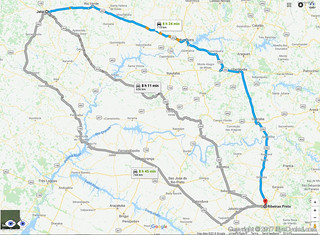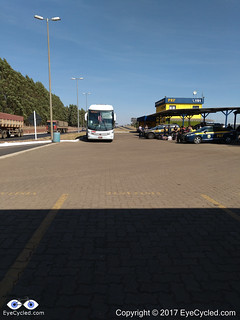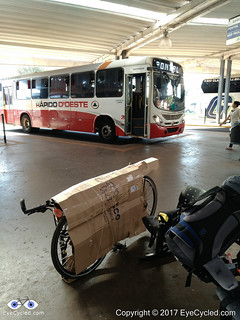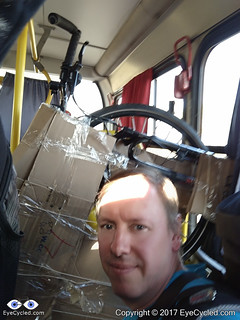Introduction to the Faith’s Way (Path of Faith) and day Zero of my pilgrimage
In this post…
Before I go on to my own introduction of the Faith’s Way, you may want to watch the Instituciona video below, produced by the Friends of the Caminho Association. I think it’s a very well made teaser of the Caminho.
Now… that should have given you a taste for the Caminho, so let’s move onto my own introduction. I speak most of this introduction on the video below, so if reading is not your thing, feel free to watch the video and skip the words.
In September 2017 I completed by bicycle the 571 Km (357 miles) of the Faith’s Way, or Caminho da Fé in Portuguese, which for me turned out to be about 600 Km due to my choices and mistakes. The Caminho da Fe is sometimes also known as the Path of Faith.

The Faith’s Way is a pilgrimage route in which the pilgrims may choose to start from different locations, depending on the distance they want to cover. I decided for the longest route starting in the small town of Sertãozinho in the State of São Paulo.
Regardless where pilgrims start, like in the pilgrimage of the Santiago de Compostela, the destination is always the same: In this case, the Catholic Basilica of the Sanctuary of our Lady in the town of Aparecida do Norte, also in the state of São Paulo.
I am posting this introduction mainly for those who have never heard of this pilgrimage route, but also for those who may already have heard of it, but have not attempted to do it yet.
The English version of this post will be rather different than the Portuguese one. Reason being is that there is already a great amount of information available in the web about the Faith’s Way, but mostly in Brazilian Portuguese.
So, while for Portuguese speakers I can just point them in the right direction and provide them with the web links, in English I think I need to provide a little more contextual information to improve understanding and be worth your time. If you can, however, read in Portuguese, a good point to start is the web site of the Friends of the Caminho Association on www.caminhodafe.com.br. I’ve been told that the English version of their page is in the works though.
There are also numerous online groups (Facebook, WhatsApp, etc) where thousands of pilgrims and pilgrims to be can exchange information and provide virtual help and support. Again, I am unaware of the existence of such groups in English Language. Please leave a comment below if you would like me to create one.
The Faith’s Way, or the “Caminho” was the brain child of 3 Brazilian Compostela pilgrims, who, after having completed the pilgrimage in Spain a few times had the idea of creating a similar pilgrimage route in Brazil, linking their home town of Águas da Prata (which translates to Silver Waters in Portuguese) in the State of São Paulo to the Sanctuary in Aparecida.
The Sanctuary in Aparecida had been a pilgrim destination for generations already, but there wasn’t up to that point an organized pilgrims’ path with hostels and support along the route, as there is on the Camino de Santiago de Compostela.
By sharing my experiences on the “Caminho” my goal is to help spread the word of this pilgrimage route outside of Brazil and, perhaps, help those who may be interested in walking or cycling the route, by showing them what to expect along the way, at least if they chose to do the same route and in the same weather conditions I did mine.
Please help me achieve my goal by clicking the “Like” or the Thumbs-up button in YouTube, leaving your questions and comments and sharing this post with others who might be interested in these types of adventure or alternative forms of traveling. Together with this post I have also published a short interview with Mr Almiro Grings, the creator of the Caminho. I recorded the interview during my passage at the Friends of the Caminho Association, which also doubles as a pilgrims’ hostel, in the town of Águas da Prata, when I got there during my pilgrimage. The video is in Portuguese with English subtitles.
Well, those that follow this blog will know that the Caminho is not my first long distance cycling pilgrimage. It is in fact the 3rd one.
In 2015 I cycled the 820 Km of the Camino de Santiago de Compostela from the French town of Saint Jean Pied de Port (known as the French way) and in 2016 I cycled 2,048 Km from the English town of Canterbury in Kent to the Vatican City in Italy in a pilgrimage route known as Via Francigena.
It is honestly not that easy to explain in detail why, in the past 3 years, I have been doing this because everyone was different, but the most simple and concise answer would be: I like the Physical and mental challenges and also the opportunities of introspection that such long bike rides allow, which are actually quite similar to those walking the way, but obviously not as time consuming.
I chose to do the Caminho from the town of Sertãozinho mainly for two reasons:
- Because there was a certain logistical advantage for me personally to start the pilgrimage from there. There is a direct bus connection between the small town I was living, at that time, in Brazil and the city of Ribeirão Preto in the state of São Paulo. Ribeirão Preto is situated just 20 Km (13 miles) away from Sertãozinho and therefore I would not need to change buses (which I ended up doing anyway, but it was beneficial and not as complicated as I thought it would be). A plus if you are carrying your luggage plus a dismantled bike with you in the bus.
- Because the route starting from Sertãozinho was, at the time I did it, the longest path to the sanctuary of Aparecida and I was keen to spend more time on the road.

If you look at the map of the Caminho, available for download from the web page of the Friends of the Caminho Association, you’ll see that you may start your pilgrimage in in many of the so called “branches” of the route or in most towns / places along the way.
The key to starting your pilgrimage and officially becoming a pilgrim is the pilgrim’s credential which you’ll find in many (but not all) places along the way.
All branches combine in Águas da Prata, which was where the Caminho was first created and from there the route to Aparecida follows the original path.
I already published all my experiences on the Camino de Santiago in 2015 in the EyeCycled blog and in the YouTube channel, but I am still working on the posts and videos of the 2016 Via Francigena pilgrimage to Rome.
With this post I am starting the pilgrimage posts and videos of the Caminho da Fé which will follow the same basic principles of previous pilgrimage posts. As my goal is to show how my pilgrimage developed, I typically turned the camera on at the start of the day’s journey and turned it off when I reached my destination for that day.
By reading or watching my experiences, future pilgrims can perhaps use them as a guide and decide to follow the same route I did, or not.
As no one in their right mind would watch several hours of cycling videos, I recorded the entire journey using a type of video recording called “Time-Lapse“. In this type of recording the camera takes a high resolution picture (4k) every 0.5 seconds and internally builds a video with them at the end of the recording.
This makes the video look very accelerated in time. In fact, each 10 minutes or so in real life represent about 10 seconds of video footage, so it is possible to watch an entire day in the journey in just a few minutes without missing a single meter of the track.
The disadvantage of these types of recordings are, obviously, the speed in which everything is shown and the vibration of the camera which in an accelerated speed is much more pronounced and notable.
This can be reduced with a device called a Gimbal, whose function I already explained in a previous blog post and videos in the channel. The Caminho was the 1st time I used this device in a consistent manner and for long distances and periods of time.
Although the gimbal helps reduce the effects of the vibration it does not eliminate them completely, due to the potholes, stones, gravel and uneven surfaces of the path, mostly on dirt roads and footpaths.
My intention is to publish posts and videos about the Caminho da Fé every two weeks, but I already know this may be just wishful thinking due to upcoming periods of intense travel and work. If you look at the map of the Caminho again, you’ll see that between Sertãozinho and Aparecida there are 21 major tracks. My intention is to publish a time lapse video for each one. I also want them to be bilingual, so current expectations are that I need to produce at least 42 videos, not counting this introduction video and other, shorter videos I recorded along the way.
This also added to the fact I will publish 1 blog post for each day of my journey in English and Portuguese as well, containing pictures, tips and highlights, so I am not making promises I won’t be able to keep. It will be done when it’s done, regardless of how long it takes.
One could say, there is a reason it is called this pilgrimage is called “The Faith’s Way”… having faith in yourself in generally a requirement. I have faith I’ll complete this work and count with your support in doing so.
I don’t do this work expecting a financial benefit in return, but I have costs to maintain the blog, such as hosting and domain reservation, and this work demands a lot of my time. In fact, it takes me a lot longer to do this as it did take me to ride the entire way, so if you are feeling generous, please go to me Patreon page through which you can contribute with a small donation to help maintain the blog running with coffee to keep me going late nights.
Video Interview with Mr Almiro Grings, the creator of the Faith’s Way
The following video interview was recorded at the Friends of the Caminho Association in Águas da Prata in September 2017.
Statistics, expenses and my daily log on the Faith’s Way
The Excel file below contains the statistics of the journey (as collected by my Garmin Edge 810), such as distances, Elevation, Speeds, Average Heart Beat, etc, as well as the expenses, accommodation and the notes I recorded along the way.

Day ZERO: My trip by bus from Jataí to Sertãozinho
 I decided to write a little about how I got to the starting point of the pilgrimage, not because it may help you direclty, but because it may get you to understand the logistics of getting to the starting point. As previously mentioned, I had to find a way to get to starting point of the pilgrimage, which I chose to be the town of Sertãozinho in the federal state of São Paulo. I was living in a small town called Jataí, in the state of Góias at the time. If you live outside of Brazil you will probably start your journey from a much bigger city, likely a capital and will have to find your own way to get to the starting point. There are buses from the city of São Paulo directly to Sertãozinho and flights to Ribeirão Preto, which is just 20 Km away from Sertãozinho.
I decided to write a little about how I got to the starting point of the pilgrimage, not because it may help you direclty, but because it may get you to understand the logistics of getting to the starting point. As previously mentioned, I had to find a way to get to starting point of the pilgrimage, which I chose to be the town of Sertãozinho in the federal state of São Paulo. I was living in a small town called Jataí, in the state of Góias at the time. If you live outside of Brazil you will probably start your journey from a much bigger city, likely a capital and will have to find your own way to get to the starting point. There are buses from the city of São Paulo directly to Sertãozinho and flights to Ribeirão Preto, which is just 20 Km away from Sertãozinho.
I tried in vain to find someone who had a car and wanted to share this adventure with me, but it is hard to find someone with the willingness to do it and, most importantly with the time, which is a significant length of time away from work, family, etc.

As I couldn’t find anyone, I started to look at the options of getting to Sertãozinho from Jataí. Jataí is a small town and doesn’t have an airport the offers regular flights. Sertãozinho is also a small town, but quite near from a bigger city called Ribeirão Preto. Ribeirão has a regional airport with flights to/from a number of destinations, including the capital of the state of Goias, Goiânia. The problem is that a trip to Goiânia is 320 Km and would have to be made by bus anyway, so as there was a directly bus connection from Jataí to Ribeirão Preto, I decided on this option. It would be a longer and less comfortable journey, but it would be direct and cheaper also. I spent R$ 135.00 on the bus ticket. The distance between Jatai and Ribeirão Preto was 715 Km, but the journey, which should have taken about 12h, was delayed for more than 2h at the station of the Federal Highway police in Uberaba, state of Minas Gerais, as they stopped and searched to bus due to an apparently anonymous tip-off they received that someone in that bus would be smuggling drugs to Sâo Paulo and the tip-off proved to be right. They found the smuggler together with 10 Kg of Cocaine Paste. Expect the unexpected!

In Ribeirão Preto I had to option of assembling the bike and riding the 20 Km to Sertãozinho, which I was advised against due to some areas of high incidence of crime I had to go through, or take an urban bus from Ribeirão Preto to Sertãozinho. As I arrived at Ribeirão Preto’s bus station, I asked around and found out from which platform the bus to Sertãozinho was departing. I had to take the lift downstairs, turn left, walk a few meters and take another lift upstairs to the platform where the local buses departed. The bus to Sertãozinho was already there and was about 3/4 full.

The problem was that that bus was a urban type and had no boot or facilities to carry bikes, so the driver told me to seat in the seat reserved for disabled people and hold the bike upright.
The journey to Sertãozinho was short, about 30 min. Upon arriving at Sertãozinho’s bus station, I assembled the bike and rode to the hotel (about 1.5 Km away). Did the check-in in the Agapito Hotel, the only hotel in the official list of accommodation of the Friends of the Caminho Association, and got my pilgrim’s credential. In the evening I met with a TV crew from Globo TV, Brazil’s largest TV network.I knew they were coming as I was told by the hotel receptionist when I called to make my reservation a few days before. We went out for a meal that evening, talked about a lot of things, incl. my previous pilgrimages and agreed on an interview in the morning the next day.
Pictures of day ZERO.
Click on any picture for full detail
If you have any questions, don’t hesitate to comment or send me a message through the contact form. Please subscribe to my Blog and/or to my YouTube channel if you don’t want to miss the next one and help me spread the word by liking and sharing my Facebook Page and Tweeter feed also.
Thank you all for your time and “Bom Caminho!”. Do you like these posts? Why, then, don’t you pay me a coffee to help with the blog hosting cost and as a caffeine incentive to keep me going through the long hours of the night? (Suggested amount: £2.00 or USD $3.00 or 2.50€ or whatever you want to give).
You may donate through my Patreon Page or through PayPal directly.
![]()

